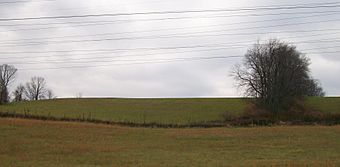Brokaw Site facts for kids
Quick facts for kids |
|
|
Brokaw Site
|
|

The Brokaw Site in 2009.
|
|
| Lua error in Module:Location_map at line 420: attempt to index field 'wikibase' (a nil value). | |
| Nearest city | St. Clairsville, Ohio |
|---|---|
| Area | 2.5 acres (1.0 ha) |
| NRHP reference No. | 76001371 |
| Added to NRHP | June 17, 1976 |
The Brokaw Site is a special historical place near St. Clairsville, Ohio. It is located off U.S. Route 40 in Richland Township. This important site was added to the National Register on June 17, 1976.
Contents
Discovering Ancient Villages
This area was once home to ancient villages. People lived here a very long time ago. They settled during the Archaic period and later the Middle to Late Woodland periods. We know this because archaeologists have found old tools and pottery here. These items help us learn about the people who lived on the land.
Why the Site Was Perfect
The main village was built on a flat hilltop. This spot is about 1,240 feet (378 meters) above sea level. The village covered about 2 to 3 acres. From this high point, people could see a hunting trail below. This trail later became part of the famous National Road.
The site also had four natural springs. These springs provided fresh water. The water flowed into a stream that led to the Ohio River. Having fresh water and a good view made this hilltop an ideal place for ancient communities to live.
Saving the Brokaw Site
Much later, a man named John Brokaw bought the land. He built his home on the same hilltop. During his time, many ancient objects were found. Because of these discoveries, Mr. Brokaw allowed archaeologists to dig and study the site. This research happened between 1972 and 1974.
After their studies, the research team wanted to protect the site. They asked Mr. Brokaw if it could be placed on the National Register. Mr. Brokaw shared that the land was above a large coal deposit. He had already given permission for mining to happen there. However, the mining was stopped. The National Park Service officially added the Brokaw Site to the National Register. This helped protect it for the future.
The Brokaw Site Today
Around the early 1900s, the entire hilltop was cleared. Farmers used the land for growing crops and for pasture. You can still see Locust and cherry trees along the old fence lines.
Today, the area around the site is changing. New houses are being built nearby. A reservoir was also dug out east of the site. Even with these changes, the Brokaw Site remains an important historical place. It helps us understand the ancient people who lived in Ohio.
Images for kids


